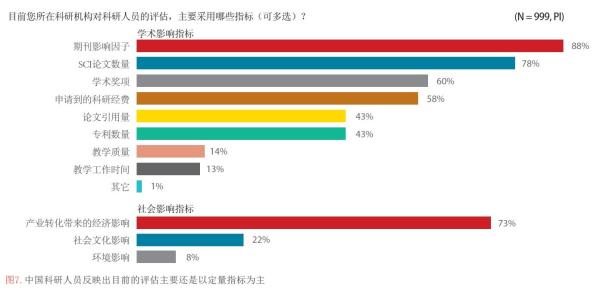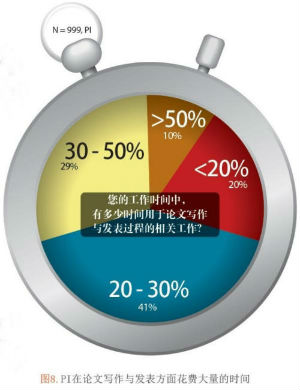Release date: 2015-12-02
Today, when academic misconduct is frequently reported, how do Chinese researchers view the current "academic circle"?
On November 26th, Nature Publishing Group (International Publishing Group, based in London, UK, with the world's top academic journals such as Nature) released the White Paper on Chinese Studies in Transition. The white paper analyzes the three stages of research funding, scientific research implementation, and scientific research communication. It aims to explore the future development direction of Chinese scientific research by understanding the experiences and needs of Chinese researchers.
The white paper writes that China's current R&D investment and scientific research output rank second in the world. China's R&D investment in 2014 was about 1.33 trillion yuan, second only to the United States. The number of papers in China's SCI (Science Citation Index) reached 245,000 in 2014, ranking second in the world.
The survey results also show that two-fifths of the respondents believe that the degree of Chinese scientific research is similar to that of foreign countries, but a similar proportion of people think that China's situation is more serious. However, 91% of respondents believe that Chinese research institutions should increase their efforts to detect, prevent and punish misconduct.
According to Nature Publishing Group, the content of the white paper is based on interviews and research conducted by more than 1,700 researchers in various research institutes across China in May and June this year. Respondents covered four major disciplines, life sciences and chemical sciences, and they all published articles in journals of the Nature Publishing Group.
China's R&D investment accounts for 2.1% of GDP
In line with the status of the world's second largest economy, China's current R&D investment and scientific research output rank second in the world. China's R&D investment in 2014 was about 1.33 trillion yuan, second only to the United States. The number of papers in China's SCI (Science Citation Index) reached 245,000 in 2014, ranking second in the world. In addition, China is the world's second largest contributor to the Nature Index, an important reference indicator for assessing the level of basic scientific research. According to the white paper, this shows China's high level of scientific research strength.
However, the problem still exists. According to the white paper, China's current scientific evaluation system, like many other countries, relies heavily on a single evaluation standard, such as the number of SCI papers published, but does not pay much attention to the economic and social impact of research. Moreover, China lacks an effective mechanism to industrialize scientific and technological achievements, which also hinders the realization of social and economic influence.
“China's scientific research, like its economy, is at a critical turning point. China needs to change its scientific research culture to focus more on quality than on quantity, thus maintaining the sustainable development of science and technology and transforming scientific research output into Productivity." The report suggests this.

In 2014, China's R&D investment accounted for 2.1% of GDP, which is comparable to that of developed countries such as the United Kingdom and the United States. However, the current funding mechanism is more biased towards applied research, and basic research funds account for only 5% of total R&D investment. Far less than 18% in the US, 16% in the UK and 12% in Japan. Of the 32 Principal Investigators (PIs) who conducted in-depth interviews, more than 80% believed that China should invest more in basic research.
This has also led to projects that are based on past research results often receiving priority funding. “If you write something very original and very novel in the application, it is often difficult to get funding. The reviewer does not necessarily understand your thoughts, or feels that the things you propose are too risky to make... but in recent years There are some special funds (to support this very innovative research), and the situation is constantly improving," said an academic leader from Xi'an.
Academic misconduct is too simple due to the evaluation mechanism

According to the survey results, two-fifths of the researchers surveyed believe that the degree of scientific research in China is roughly the same as that in foreign countries, but a similar proportion of people think that the situation in China is more serious.
Among the more than 1,700 researchers, 91% believe that Chinese research institutions should increase their efforts to detect, prevent and punish misconduct. This includes strengthening the monitoring, implementing strong penalties for standardization, and investigating violations in a transparent manner.
In the turmoil of the high-profile and controversial Tsinghua University in the past, the suspected act of robbing, concealing, lying, and other unfair means of capturing the results of the project has stunned the outside world, and both sides have accused each other on the issue of signature.

The white paper pointed out that the author's signature may be the biggest problem facing scientific research cooperation. This problem is particularly difficult in domestic research cooperation, because many Chinese researchers want to be the first author or correspondent (project leader), so their work Will be recognized by the organization and funding agencies.
The root of this problem lies in the fact that the evaluation mechanism is too simple, and it emphasizes the number of articles published, and completely blames the article on the first author or correspondent author, lacking a more reasonable distribution mechanism that recognizes the contributions of multiple co-authors.
“In many cases, the cause of scientific misconduct comes from the scientific evaluation system. Because the system often simply links economic interests and career prospects with quantitative indicators, such as the number of papers published—especially when the impact factor reaches a certain level or higher. The number of journals, as well as the amount of money obtained."
The white paper concludes that the pressure of a large number of articles may lead researchers to take shortcuts and lead to various academic misconducts. China's top scientific research institutions such as the Chinese Academy of Sciences have taken measures to establish a more reasonable evaluation system that combines qualitative evaluation.
Researchers spend very little time on science communication
In a narrow sense, research communication is the sharing of research results with other scientists; in a broad sense, this concept includes the interaction and communication of the general public, policy makers and business leaders.
In 2012, surveys of some publications, including the journal Nature, showed that papers from China suffered a relatively high rejection rate.
Then, if we increase the number of Chinese reviewers (the results of the research are sent to academic journals, they will be reviewed by professional review teams from various countries), can this problem be solved? Unexpectedly, the academic leaders surveyed will review China. The manuscripts have different attitudes. Some people worry that Chinese reviewers may be more demanding for domestic counterparts because of direct competition.
But the white paper says that there are still too few Chinese reviewers compared to more and more high-level papers published by Chinese researchers.

The study also analyzed that although Chinese researchers are strongly aware of the importance of disseminating research to the public, they are often immersed in writing and publishing papers. According to the survey, only about half of people have actually participated in some form of scientific communication activities in the past three years.
"This may be beneficial to the progress of science. It is necessary to put all the data on the open platform. It takes a lot of time and effort to sort out the data. And maybe there will be people asking questions after the disclosure, it will involve more energy. To explain. As far as I am concerned, I am not willing to do this if it is not a hard requirement," said an academic leader from Beijing.
In the white paper analysis, China emphasizes that modest cultural traditions hinder the interaction between researchers and the media. In addition, many administrative barriers in Chinese research culture are another important factor. Applying for funds, writing and publishing papers, and some senior scientists take extra time in administrative positions. In contrast, scientific communication relies on the side, and researchers do not have much time to do such work.
According to the latest survey conducted by the China Association of Science and Technology this year, only 6.2% of Chinese residents have basic scientific literacy, far below the level of some developed countries. In fact, the public participation of scientists and the scientific literacy of the people are mutually causal.
Source: Green Office
Levee Plastering Machine,Terraced Paddy Field Ridge Building Machine,Ridge Construction Machine For Paddy Field,Large Ridge Building Machine
Taizhou Yingtian Agricultural Machinery Manufacturing Co., Ltd. , https://www.sakuradaagc.com